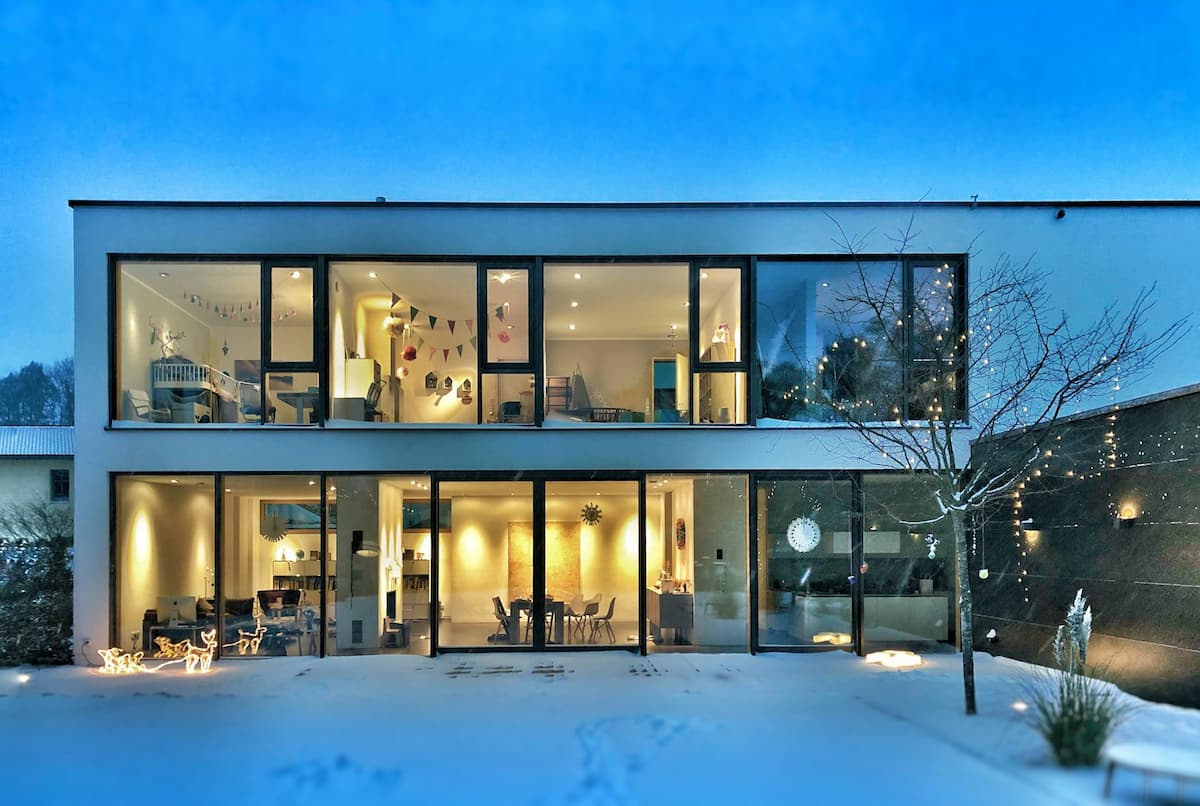Incorporating modern design trends into major home renovations
Updating your home’s design to reflect modern trends can breathe new life into your living space and significantly enhance its value. Major home renovations offer the perfect opportunity to incorporate contemporary design elements that not only improve aesthetics but also increase functionality and comfort. Modern design trends are constantly evolving, influenced by changing lifestyles, technological advancements, and a growing emphasis on sustainability. By incorporating these trends, homeowners can create a living environment that is stylish, practical, and aligned with current preferences.
Successful integration of modern design trends requires careful planning and consideration. It’s not simply about following what’s popular; it’s about selecting trends that enhance your home’s unique character and meet your specific needs.

Let’s discuss this further below:
1. Hiring a Professional Home Remodeler
When undertaking major home renovations, hiring a professional home remodeler is essential. These experts bring a wealth of knowledge and experience to the table, ensuring that your project is completed efficiently and to a high standard. An experienced home remodelling company can help you navigate the complexities of a renovation, from initial planning and design to construction and final touches. They can provide valuable insights into the latest design trends and how to incorporate them into your home effectively.
For a seamless renovation that incorporates the latest trends, hiring a home remodeling contractor ensures professional expertise and quality results. These professionals are well-versed in modern design principles and can suggest innovative solutions that align with your vision. They also manage all aspects of the project, including coordinating with other tradespeople, sourcing materials, and ensuring compliance with local building codes.
It is advisable to hire professional remodelers for projects such as bathroom renovations, sunroom upgrades, or exterior modifications like replacing windows and doors.
2. Open-Concept Living Spaces
One of the most popular trends in modern home design is the open-concept living space. This design approach involves removing walls to create a more fluid and spacious environment. Open floor plans enhance the flow of natural light, making homes feel brighter and more welcoming. They also foster better social interaction by merging living, dining, and kitchen areas into one cohesive space. This layout is ideal for families and those who love to entertain, as it allows for more flexible use of space and easier communication.
Creating an open concept space requires careful planning to maintain structural integrity and functionality. It’s important to consider the placement of load-bearing walls and the overall layout to ensure the space remains practical and safe. A professional contractor can help with these considerations, ensuring that the design is both aesthetically pleasing and structurally sound. Additionally, thoughtful use of furniture, area rugs, and lighting can help define different areas within the open space, maintaining a sense of organisation and purpose.
3. Sustainable and Eco-Friendly Materials
Sustainability has become a key focus in modern home renovations, driven by a growing awareness of environmental issues and a desire to reduce our carbon footprint. Using eco-friendly materials in your renovation not only benefits the environment but can also improve indoor air quality and increase the appeal of your home to eco-conscious buyers. Popular sustainable materials include reclaimed wood, bamboo, recycled metal, and low-VOC paints. These materials are not only environmentally friendly but also durable and stylish.
Incorporating sustainable materials into your home renovation can be done in various ways. Reclaimed wood, for instance, can be used for flooring, cabinetry, or accent walls, adding a rustic charm while promoting sustainability. Bamboo is another excellent option, known for its rapid growth and renewability, making it ideal for flooring and furniture. Recycled metal can be used for countertops, backsplashes, and fixtures, offering a sleek, modern look.
4. Smart Home Technology Integration
Smart home technology is rapidly becoming a staple in modern home renovations, offering increased convenience, energy efficiency, and security. Integrating devices such as smart lighting, thermostats, security systems, and home assistants can significantly enhance the functionality of your home. These technologies allow homeowners to control various aspects of their home environment remotely or through voice commands, making daily routines more manageable and efficient.
Incorporating smart home technology into your renovation requires careful planning and expertise. A professional home remodelling company can help design a system that is tailored to your needs and seamlessly integrated into your home. They can recommend the best products and ensure that all devices are properly installed and configured.
5. Minimalist and Functional Design
Minimalist design is a trend that emphasises simplicity, functionality, and the use of clean lines. This approach focuses on decluttering spaces and choosing furnishings and decor that serve multiple purposes. The result is a home that feels spacious, organised, and serene. In a minimalist design, every element should have a purpose, and unnecessary items should be eliminated.
Achieving a minimalist look involves a careful selection of furniture, storage solutions, and decor. Opt for built-in storage to keep surfaces clear and create a streamlined appearance. Choose multifunctional furniture, such as ottomans with storage or fold-out tables, to maximise space. Using a neutral colour palette with a few accent colours can help create a calm and cohesive environment. A professional contractor can assist in designing and implementing these minimalist elements to ensure a functional and stylish outcome.
6. Indoor-Outdoor Living Spaces
Creating a seamless transition between indoor and outdoor living spaces is a popular trend in modern home design. This approach extends the living area of your home, making it more versatile and enjoyable. Features such as large sliding or bi-fold doors, outdoor kitchens, and covered patios can blur the lines between indoors and outdoors, creating a unified space for relaxation and entertainment. This design trend not only enhances the aesthetic appeal of your home but also provides additional space for activities and gatherings.
Designing an indoor-outdoor living space requires careful planning to ensure comfort and usability throughout the year. Consider incorporating elements such as weather-resistant furniture, outdoor heating, and shading solutions to make the space functional in various weather conditions. Landscaping also plays a crucial role in creating a harmonious connection between indoor and outdoor areas.
Conclusion
Incorporating modern design trends into major home renovations can significantly enhance the functionality, comfort, and aesthetic appeal of your home. Hiring professional home remodelers ensures that these trends are effectively integrated into your renovation project. Whether you’re renovating to enhance your own living experience or to increase your home’s appeal to potential buyers, staying up-to-date with modern design trends is a worthwhile investment.

![[AD] We’re a cricket-mad family, so we’re buzzing that @thehundred is back this August! 🏏🔥
To get ready, M tried out the official FREE Activity Pack — and it’s brilliant! 🙌
Packed with fun games, creative challenges and sporty tasks, it’s perfect for getting kids hyped whether you’re at home or on the go.
👉Download yours now (link in bio)
@londonspirit @ovalinvincibles #EveryMomentCounts #TheHundred
#EnglandCricket #CricketFamily #TheHundredCricket #LondonBloggers #Cricket #CricketIsLife #kidsfun](https://suburban-mum.com/wp-content/uploads/2022/11/505472555_18531279601016840_7092520074819907569_n-180x320.jpg)



![[AD - Press visit]
We enjoyed the glorious sunshine this weekend with a trip to Brighton. We went on the @brightoni360official which is right by the sea front.
The i360 pod take a slow journey up, allowing you to take in views across Brighton and the South Downs 450ft above ground. There’s a bar inside with drinks and snacks available to purchase and the experience lasts 25 minutes.
Afterwards, we headed to the open air roller rink for a roller skating session!
The roller rink is:
⭐ Suitable for over 5s
⭐ £6.50 if you have your own skates or £9.50 if you need to hire them
⭐ 45 minutes per session
Full details to visit the i360 + skating
📍 Brighton i360, Lower Kings Road, Brighton BN1 2LN
🚗 Parking nearby (we parked in the Regency Square Car park)
🎟️ Prices start from £25.40 for an adult and £16.90 for a child
🕐 Opening hours are currently Sun-Fri 10.30am-18.30pm and until 19.30pm on Saturdays
☕️ Bar inside the i360, cafe and gift shop
Book tickets here:
https://tickets.brightoni360.co.uk/tickets/?_ga=2.195305772.1869001490.1689671753-1757164059.1689671753/#events?eventid=157](https://suburban-mum.com/wp-content/uploads/2015/04/417980235_313576471048632_3682382982231216432_n.jpg)

![[AD] ***Summer of fun at Barracudas Activity Camps!****
There is plenty for kids to do at @barracudas_activity_day_camps
From Tennis, Archery, Swimming, Motor Sports and more you can be sure that there will be something for kids aged 4.5-14. ⚽🏈🥅🎾🏓🏎️🏹🏊♂️🏉
You can book on a day by day basis - so it can fit in with any other days out/activities you have planned and there are early drop off and late pickup options available. Barracudas are also Ofsted registered so you can use your Childcare Vouchers too.
⭐⭐⭐Get £20 off a week or £4 off a day using my discount code: MARIA20⭐⭐⭐
#BarracudasActivityDayCamp #BarracudasActivityCamp #BarracudaAmbassadors #SummerHolidays #SchoolHolidays #Summer2023 #SummerCamp #DayCare #Camp #KidsCamp #surreymummy #surreymums #SummerOfFun #ActivityCamps #HolidayCamps #Childcare #SchoolHolidays #schoolholidaycamps](https://suburban-mum.com/wp-content/uploads/2024/07/353583570_625625966167953_545896259645102575_n.jpg)



![[AD] We have some super exciting news...we have been chosen to be Laser Quest Ambassadors, and the boys are over the moon!
We are really lucky that our local Laser Quest (@laserquestkingston) is just around the corner from us. It means we can pop in of a weekend or anytime during the school holidays, and with summer just around the corner, I know Laser Quest will be one of our go-to places for some family fun.
As well as games of Laser Quest, there are also VR experiences and arcade amusements too. To find out a bit more about how Laser Quest works, you can read my blog post: https://www.suburban-mum.com/laser-quest-kingston/ (clickable link in bio)
Don't forget to keep an eye out for our Laser Quest posts - I'm going to be giving away two family passes to use at Laserquest Kingston!
If you can't wait and want to head down to Laser Quest to try it out, use the code SUMMER30 for 30% off your booking. The code is valid from now until the end of August 2023 and can be used on Laser Quest games and birthday party bookings.
#LaserquestAmbassador #Laserquest #LaserquestKingston #ActivitiesForKids #FamilyFun #DaysOutWithKids #Lasertag #LaserquestVR #Kingston #ThingsToDoInKingston #SurreyFamilyDaysOut #ThingsToDoWithKids #RainyDayFun #SurreyMummy #SurreyLife #LifeWithKids #LifeWithBoys #familyfunday](https://suburban-mum.com/wp-content/uploads/2015/04/353230107_797358078406942_2405522556733455165_n.jpg)

![[AD] The sun has finally made an appearance and the boys have been making the most of it by spending it
in the garden.
They’re go-to is always football and they’ve been trying to improve their aim and accuracy with the new Messi Foldable Footlball goal from the #MessiTrainingSystem range.
I love the fact the goal is foldable, making it easy to store away when not in use. It is also lightweight so you can effortlessly pack it up and take it to the park or to a friend’s house.
The Messi Foldable Football Goal retails at £36 and can be purchased from @argos
You can read my full review here: https://www.suburban-mum.com/messi-foldable-football-goal/
#TrainLikeMessi #FoldableFootballGoal #FootballSkills #OutdoorFun #LionelMessi #LeoMessi #FootballAtHome #OutdoorKids #JustGetOutside #OutdoorsAndFree #ScreenFreeKids #WhateverTheWeatherKids @flair_gp](https://suburban-mum.com/wp-content/uploads/2015/04/341194882_615024710178056_41977149395989448_n.jpg)

![[AD] We are absolutely thrilled to announce that we are Barracuda Ambassadors again this year.
With Easter just around the corner, the boys were sent the @barracudas_activity_day_camps new camp kit in preparation for the school holidays.
There’s a wide range of activities for kids aged 4.5 - 14 including Tennis, Archery, Basketball, Arts & Crafts and more.
If you like the sound of Barracudas, find out more over on their website. You can also save £20 a week or £4 a day, using my discount code: MARIA20](https://suburban-mum.com/wp-content/uploads/2024/07/336812306_765234558514317_685553691647241974_n.jpg)


![[AD - Gifted]
Last weekend we were invited to try out @tsarettaspice’s new Bottomless Brunch menu and I can tell you it was thumbs up all round!
There’s a good choice tapas on offer from Punjabi fish fingers, Indo Chinese Chicken to Spiced Lamb Scotch Eggs and Manchurian Cauliflower (which was amazing!)
If you’re local to Twickenham and fancy giving them a try here’s are the details.
Tsaretta Spice Bottomless Brunch
⭐️£37.50 per head for bottomless Prosecco or cocktail of the day
⭐️£55 per head for bottomless Champagne
⭐️ Food included: 4 tapas selections and dessert or 2 tapas selections, a pav or naanwich and dessert
⭐️ Non-alcohol brunch is also available
Tsaretta Spice
55 Church Street
Twickenham
TW1 3NR
You can also read our full review over on the blog (link in bio)](https://suburban-mum.com/wp-content/uploads/2024/07/334565436_5960402314015030_663031098700829518_n.jpg)
![[AD] What does family look like for you?
I am fortunate to be surrounded by strong, powerful women in the form of my mum, sister and mother-in-law (along with many others). With Mother’s Day just around the corner, @BootsUK want to celebrate all the different mums and mother figures we are lucky enough to have in our lives. They have a huge range of Mother’s Day gifts to choose from so we can show them how much they mean to us. (swipe to take a look at some of my choices)
If you want to express love and appreciation for the mother figure(s) in your life, head to Boots.com to find the ideal gift. They have a whole host of gifts, so you can be sure to find something to suit all tastes. Celebrate the #LoveForAllMums this Mother’s Day with Boots.
](https://suburban-mum.com/wp-content/uploads/2015/04/334276459_136658625736352_6403224988403337253_n.jpg)



